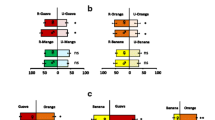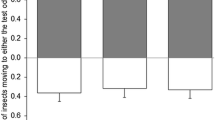Abstract
Coupled gas chromatography-electroantennogram detection (GC-EAD) analysis of volatiles from tropical almond fruit, Terminalia catappa L., revealed 22 compounds that were detected by antennae of oriental fruit fly females, Bactrocera dorsalis (Hendel). Both solid-phase microextraction (SPME) and Porapak Q were used for sampling odors in fruit headspace, with SPME collections producing larger EAD responses from a greater number of compounds. Geranyl acetate and methyl eugenol elicited the largest EAD responses. A synthetic blend containing SPME collected, EAD stimulatory compounds showed female-biased attraction in laboratory wind tunnel bioassays, but heavily male-biased trap captures in a larger olfactometer arena. A nine-component subset of compounds eliciting relatively small EAD responses (EAD minor) and consisting of equal parts ethanol, ethyl acetate, ethyl hexanoate, hexyl acetate, linalyl acetate, ethyl nonanate, nonyl acetate, ethyl cinnamate, and (E)-β-farnesene, attracted mainly females. This EAD minor blend was as attractive to females and much less attractive to males when compared to torula yeast in field cage experiments using glass McPhail traps. Similar results were obtained with outdoor rotating olfactometer tests in which the EAD minor blend was almost completely inactive for males.


Similar content being viewed by others
References
Chien, C. C. and Yaw, J. D. 2000. Attraction of the Oriental fruit fly (Bactrocera dorsalis Hendel) (Diptera: Tephritidae), to leaf extracts of five plants. Chin. J. Entomol. 20:37–44.
Clarke, A. R., Allwood, A., Chinajariyawong, A., Drew, R. A. I., Hengsawad, C., Jirasurat, M., Kong Krong, C., Kritsaneepaiboon, S., and Vijaysegaran, S. 2001. Seasonal abundance and host use patterns of seven Bactrocera Macquart species (Diptera: Tephritidae) in Thailand and Peninsular Malaysia. Raffles B. Zool. 49:207–220.
Cosse, A. A., Todd, J. L., Millar, J. G., Martinez, L. A., and Baker, T. C. 1995. Electroantennographic and coupled gas chromatographic–electroantennographic responses of the Mediterranean fruit fly, Ceratitis capitata, to male-produced volatiles and mango odor. J. Chem. Ecol. 21:1823–1836.
Diaz-Fleischer, F., Papaj, D. R., Prokopy, R. J., Norrbom, A. L., and Aluja, M. 1999. Evolution of fruit fly oviposition behavior, pp. 811–841, in M. Aluja, and A. Norrbom (eds.). Fruit Flies (Tephritidae) Phylogeny and Evolution of Behavior. CRC Press, Boca Raton.
Drew, R. A. I. 1989. The tropical fruit flies (Diptera: Tephritidae: Dacinae) of the Australasian and Oceanian regions. Mem. Queensl. Mus. 26:1–521.
Hull, C. D. and Cribb, B. W. 2001. Olfaction in the Queensland fruit fly, Bactrocera tryoni. I. Identification of olfactory receptor neuron types responding to environmental odors. J. Chem. Ecol. 27:871–887.
Hwang, J. S., Yen, Y. P., Chang, M. C., and Liu, C. Y. 2002. Extraction and identification of volatile components of guava fruits and their attraction to Oriental fruit fly, Bactrocera dorsalis (Hendel). Plant Prot. 44:279–302.
Jang, E. B. 2003. Physiology of mating behavior in Mediterranean fruit fly (Diptera: Tephritidae): Chemoreception and male accessory gland fluids in female post-mating behavior. Fla. Entomol. 85:89–93.
Jang, E. B., Carvalho, L. A., and Stark, J. D. 1997. Attraction of female oriental fruit fly, Bactrocera dorsalis, to volatile semiochemicals from leaves and extracts of a nonhost plant, Panax (Polyscias guilfoylei) in laboratory and olfactometer assays. J. Chem. Ecol. 23:1389–1401.
Jang, E. B. and Light, D. M. 1996. Olfactory semiochemicals of tephritids., pp. 73–90, in B. A. McPheron and G. J. Steck (eds.). Fruit Fly Pests: A World Assessment of Their Biology and Management. St. Lucie Press, Delray Beach, FL.
Jang, E. B., Light, D. M., Binder, R. G., Flath, R. A., and Carvalho, L. A. 1994. Attraction of female Mediterranean fruit flies to the five major components of male-produced pheromone in a laboratory flight tunnel. J. Chem. Ecol. 20:9–20.
Jang, E. B., Light, D. M., Flath, R. A., Nagata, J. T., and Mon, T. R. 1989. Electroantennogram responses of the Mediterranean fruit fly, Ceratitis capitata to identified volatile constituents from calling males. Entomol. Exp. Appl. 50:7–19.
Jang, E. B., Mcinnis, D. O., Kurashima, R., and Carvalho, L. A. 1999. Behavioural switch of female Mediterranean fruit fly, Ceratitis capitata: Mating and oviposition activity in outdoor field cages in Hawaii. Agric. For. Entomol. 1:179–184.
Jang, E. B., Mcinnis, D. O., Lance, D. R., and Carvalho, L. A. 1998. Mating-induced changes in olfactory-mediated behavior of laboratory-reared normal, sterile, and wild female Mediterranean fruit flies (Diptera: Tephritidae) mated to conspecific males. Ann. Entomol. Soc. Am. 91:139–144.
Lee, K., Lin, J., and Wu, C. 1997. Electroantennogram responses of the Oriental fruit fly (Bactrocera dorsalis Hendel) to methyl eugenol. Biol. Bull. Natl. Taiwan Normal Univ. 32:71–77.
Lee, K., Lin, J., and Wu, C. 1998. Electroantennogram of the oriental fruit fly, Bactrocera dorsalis (Hendel) (Diptera: Trypetidae) to some short-chain organic acids. Chin. J. Entomol. 18:1–11.
Light, D. M. and Jang, E. B. 1987. Electroantennogram responses of the Oriental fruit fly, Dacus dorsalis, to a spectrum of alcohol and aldehyde plant volatiles. Entomol. Exp. Appl. 45:55–64.
Light, D. M., Jang, E. B., and Dickens, J. C. 1988. Electroantennogram responses of the Mediterranean fruit fly, Ceratitis capitata, to a spectrum of plant volatiles. J. Chem. Ecol. 14:159–180.
Light, D. M., Jang, E. B., and Flath, R. A. 1992. Electroantennogram responses of the Mediterranean fruit fly, Ceratitis capitata, to the volatile constituents of nectarines. Entomol. Exp. Appl. 63:13–26.
Metcalf, R. L. and Metcalf, E. R. 1992. Fruit flies of the family Tephritidae, pp. 109–152, in R. L. Metcalf and E. R. Metcalf (eds.). Plant Kairomones in Insect Ecology and Control. Chapman & Hall, New York, NY.
Nojima, S., Linn, J., and Roelofs, W. 2003a. Identification of host fruit volatiles from flowering dogwood (Cornus florida) attractive to dogwood-origin Rhagoletis pomonella flies. J. Chem. Ecol. 29:2347–2357.
Nojima, S., Morris, B., Roelofs, W., Zhang, A., and Linn, J. 2003b. Identification of host fruit volatiles from hawthorn (Crataegus spp.) attractive to hawthorn-origin Rhagoletis pomonella flies. J. Chem. Ecol. 29:321–336.
Raghu, S. 2004. Functional significance of phytochemical lures to dacine fruit flies (Diptera: Tephritidae): An ecological and evolutionary synthesis. Bull. Entomol. Res. 94:385–399.
SAS, 2000. The SAS system for Windows [V8]. Cary, NC, SAS Institute Inc.
Siderhurst, M. S. and Jang, E. B. 2006. Attraction of female Oriental fruit fly, Bactrocera dorsalis, to Terminalia catappa fruit in wind tunnel and olfactometer tests. Formosan Entomol. 26:45–55.
Stenliski, L. L. and Liburd, O. E. 2002. Attraction of apple maggot flies (Diptera: Tephritidae) to synthetic fruit volatile compounds and food attractants in Michigan apple orchards. Great Lakes Entomol. 35:37–46.
Tanaka, N., Okumoto, R. and Chambers, D. L. 1969. Low cost larval rearing medium for mass production of Oriental and Mediterranean fruit flies. J. Econ. Entomol. 62:967–968.
Yarden, G., Shani, A., and Leal, W. S. 1996. (Z,E)-α -Farnesene—An electroantennogram-active component of Maladera matrida volatiles. Bioorg. Med. Chem. 4:283–287.
Zhang, A., Linn, J., Reissig, W., Roelofs, W., Wright, S., Prokopy, R., and Zhang, A. 1999. Identification of a new blend of apple volatiles attractive to the apple maggot, Rhagoletis pomonella. J. Chem. Ecol. 25:1221–1232.
Acknowledgments
We thank Lori Carvalho and Janice Nagata for their assistance in conducting behavioral bioassays and electrophysiological recordings and Charlie Rodd for providing fruit from Kauai. We also thank Dr. J. C. Dickens, Dr. C. Linn Jr., and Dr. D. M. Light for their helpful comments on an early version of this manuscript.
Author information
Authors and Affiliations
Corresponding author
Rights and permissions
About this article
Cite this article
Siderhurst, M.S., Jang, E.B. Female-Biased Attraction of Oriental Fruit Fly, Bactrocera dorsalis (Hendel), to a Blend of Host Fruit Volatiles From Terminalia catappa L.. J Chem Ecol 32, 2513–2524 (2006). https://doi.org/10.1007/s10886-006-9160-6
Published:
Issue Date:
DOI: https://doi.org/10.1007/s10886-006-9160-6




